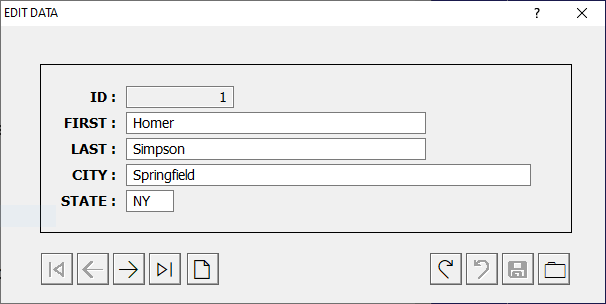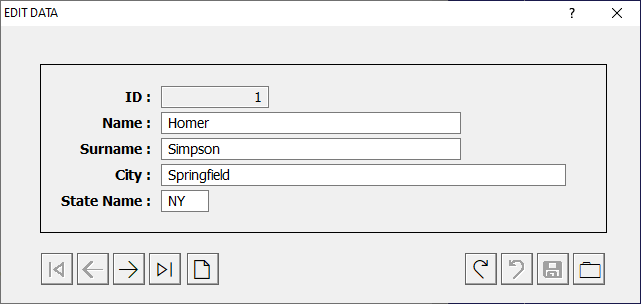Hola,
Me parece interesante el funcionamiento de la función referida.
Quisiera hacer algo similar pero pudiendo trabajar con un recorset principal que se despliega en el xedit y otros secundarios que se usan para comboboxes, así como un título
blocks de Código para antes y después de la ejecución de la función... etc.
Me interesa la forma en que xEdit() crea la ventana de datos y manipula la tabla.
¿Donde está esta función en el código disponible de FWH?
Cualquier sugerencia o ayuda es bienvenida....
Gracias
FUNCION XEDIT DE FWH
6 posts • Page 1 of 1
FUNCION XEDIT DE FWH
Saludos/Regards,
José Murugosa
"Los errores en programación, siempre están entre la silla y el teclado y la IA!!"
José Murugosa
"Los errores en programación, siempre están entre la silla y el teclado y la IA!!"
-

jose_murugosa - Posts: 1181
- Joined: Mon Feb 06, 2006 4:28 pm
- Location: Uruguay
Re: FUNCION XEDIT DE FWH
José,
Revisa FWH\source\classes\datarow.prg
Revisa FWH\source\classes\datarow.prg
-

Antonio Linares - Site Admin
- Posts: 42126
- Joined: Thu Oct 06, 2005 5:47 pm
- Location: Spain
Re: FUNCION XEDIT DE FWH
El código de FW_Record, está disponible?
Sería interesante que manejara un array para los nombres a desplegar para los campos, a fin de que si este array contiene datos, en lugar de desplegar los nombres de los campos desplegara las descripciones de los mismos...
Una sugerencia..
Sería interesante que manejara un array para los nombres a desplegar para los campos, a fin de que si este array contiene datos, en lugar de desplegar los nombres de los campos desplegara las descripciones de los mismos...
Una sugerencia..
Saludos/Regards,
José Murugosa
"Los errores en programación, siempre están entre la silla y el teclado y la IA!!"
José Murugosa
"Los errores en programación, siempre están entre la silla y el teclado y la IA!!"
-

jose_murugosa - Posts: 1181
- Joined: Mon Feb 06, 2006 4:28 pm
- Location: Uruguay
Re: FUNCION XEDIT DE FWH
José,
Está todo en el mismo PRG
Le comento a Rao tu sugerencia, gracias
Está todo en el mismo PRG
Le comento a Rao tu sugerencia, gracias
-

Antonio Linares - Site Admin
- Posts: 42126
- Joined: Thu Oct 06, 2005 5:47 pm
- Location: Spain
Re: FUNCION XEDIT DE FWH
Please see fwh\source\classes\datarow.prg.
function xEdit() is a quick way to call FW_Record():New(...):Edit()
Params:
1) uSource (optional): Defaults to the selected alias()
Values can be Alias name, ADO RecordSet object, FWH Maria RowSet, Dolphin Query, xBrowse Object, Array, Hash.
2) cFieldList (optional): Defaults to all fields.
3) lAppend: (optional) efaults to current record.
efaults to current record.
FW_Record and TDataRow are two names of the same class.
oRec := FW_Record():New(...) is identical to
oRec := TDataRow():New(...)
Datarow.prg contains full code of the class. You may study. Actually without programmers knowledge, xbrowse internall uses this class for editing records.
FW_Record/TDataRow class has many features and you will know when you study the entire source.
Sample program: Build and run in \fwh\samples folder:

What you are asking is achieved by using oRec:SetPrompt( aPrompts )

Among many other things, you can have comboboxes like this:

You will find many other featues, if you keep exploring.
Please also note that the dialog is made on scroll panel and therefore there is no limit for the number of fields.
This dialog also provides for navigation of the database.
- Code: Select all Expand view RUN
function XEdit( uSource, cFieldList, lNew )
return FW_Record():New( uSource, cFieldList, lNew ):Edit()
function xEdit() is a quick way to call FW_Record():New(...):Edit()
Params:
1) uSource (optional): Defaults to the selected alias()
Values can be Alias name, ADO RecordSet object, FWH Maria RowSet, Dolphin Query, xBrowse Object, Array, Hash.
2) cFieldList (optional): Defaults to all fields.
3) lAppend: (optional)
FW_Record and TDataRow are two names of the same class.
oRec := FW_Record():New(...) is identical to
oRec := TDataRow():New(...)
Datarow.prg contains full code of the class. You may study. Actually without programmers knowledge, xbrowse internall uses this class for editing records.
FW_Record/TDataRow class has many features and you will know when you study the entire source.
Sample program: Build and run in \fwh\samples folder:
- Code: Select all Expand view RUN
function TestDataRow
local oCn, oRs, oRec, aStates
USE STATES
aStates := FW_DbfToArray()
CLOSE STATES
oCn := FW_OpenAdoConnection( "xbrtest.mdb" )
oRs := FW_OpenRecordSet( oCn, "SELECT ID,FIRST,LAST,CITY,STATE FROM CUSTOMER" )
oRec := FW_Record():New( oRs )
oRec:Edit()
oRec:SetPrompt( { { "first", "Name" }, { "Last", "Surname" }, ;
{ "CITY", "City" }, { "State", "State Name" } } )
oRec:Edit()
oRec:FieldCbxItems( "state", aStates )
oRec:Edit()
oRs:Close()
oCn:Close()
return nil

What you are asking is achieved by using oRec:SetPrompt( aPrompts )
- Code: Select all Expand view RUN
oRec:SetPrompt( { { "first", "Name" }, { "Last", "Surname" }, ;
{ "CITY", "City" }, { "State", "State Name" } } )

Among many other things, you can have comboboxes like this:
- Code: Select all Expand view RUN
oRec:FieldCbxItems( "state", aStates )

You will find many other featues, if you keep exploring.
Please also note that the dialog is made on scroll panel and therefore there is no limit for the number of fields.
This dialog also provides for navigation of the database.
Regards
G. N. Rao.
Hyderabad, India
G. N. Rao.
Hyderabad, India
-

nageswaragunupudi - Posts: 10662
- Joined: Sun Nov 19, 2006 5:22 am
- Location: India
Re: FUNCION XEDIT DE FWH
Mr. Rao,
La verdad es mas potente de lo que creía, estaré investigándolo por unos días.
Muchas gracias por su ayuda y sugerencias y su excelente disposición de siempre.
La verdad es mas potente de lo que creía, estaré investigándolo por unos días.
Muchas gracias por su ayuda y sugerencias y su excelente disposición de siempre.
Saludos/Regards,
José Murugosa
"Los errores en programación, siempre están entre la silla y el teclado y la IA!!"
José Murugosa
"Los errores en programación, siempre están entre la silla y el teclado y la IA!!"
-

jose_murugosa - Posts: 1181
- Joined: Mon Feb 06, 2006 4:28 pm
- Location: Uruguay
6 posts • Page 1 of 1
Return to FiveWin para Harbour/xHarbour
Who is online
Users browsing this forum: No registered users and 79 guests
